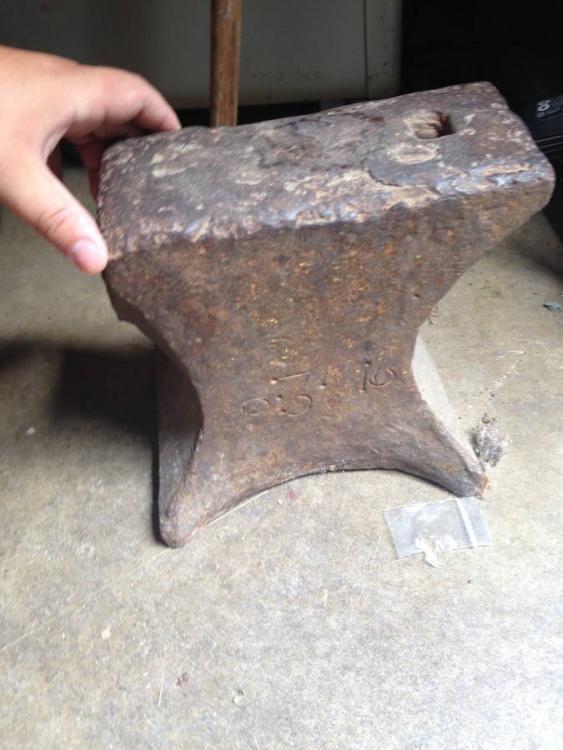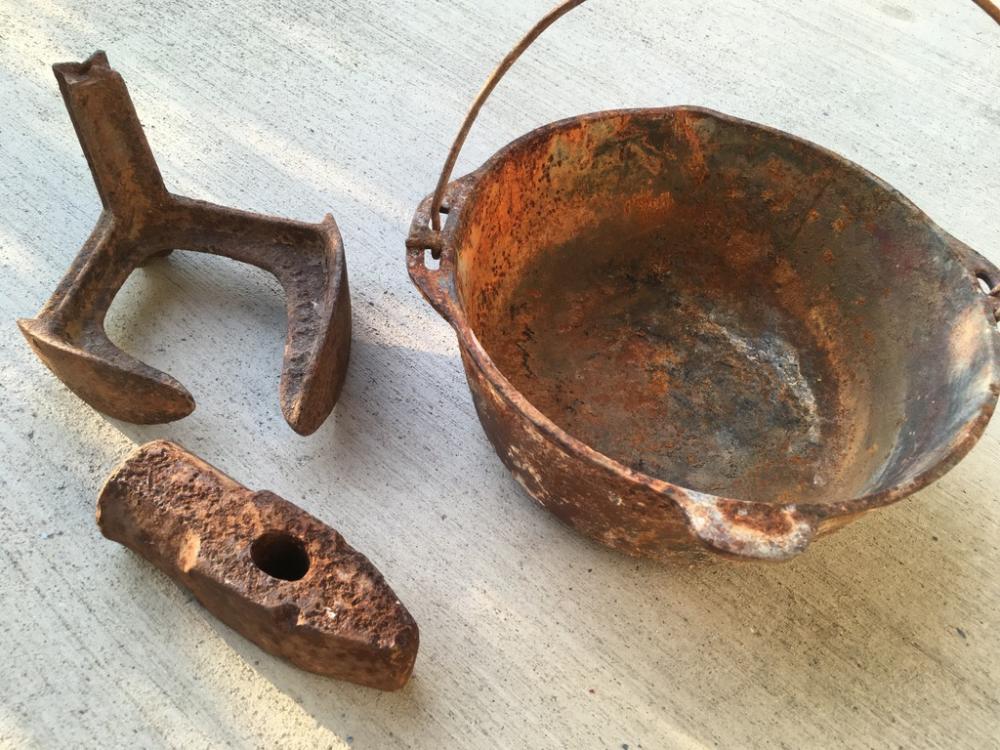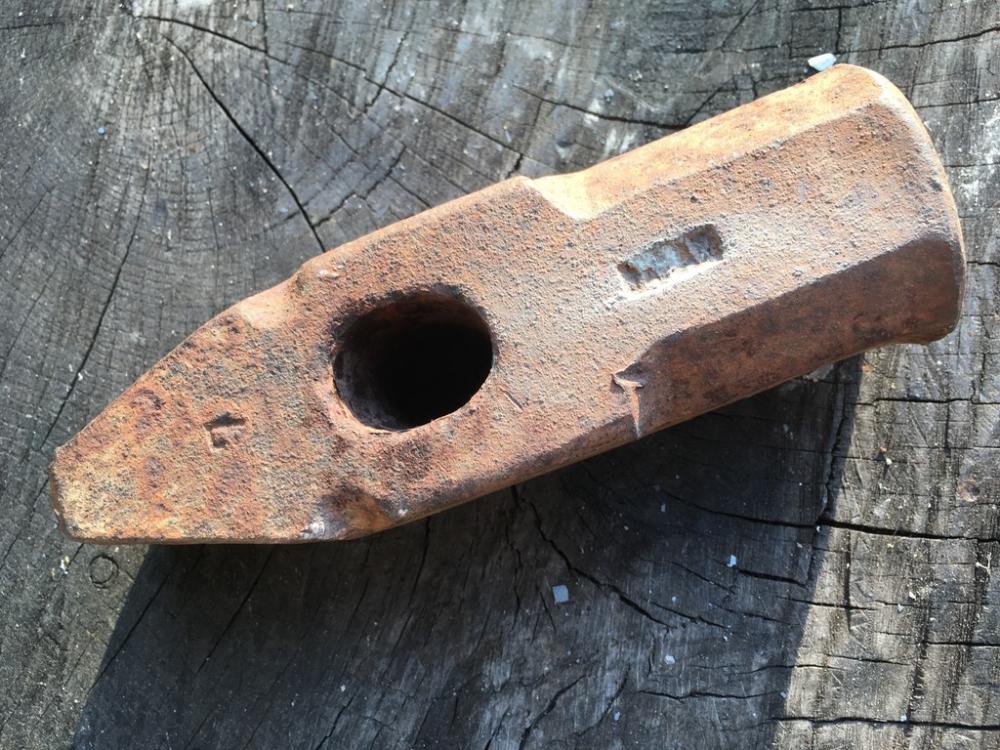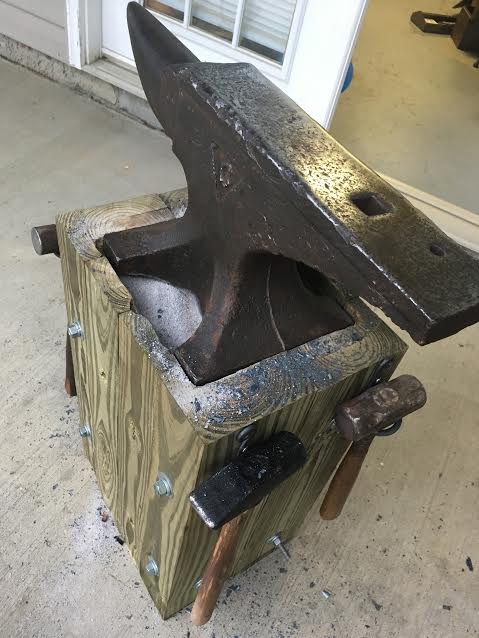
WNC Goater
Members-
Posts
84 -
Joined
-
Last visited
Content Type
Profiles
Forums
Articles
Gallery
Downloads
Events
Everything posted by WNC Goater
-
You mention melting for selling and melting for projects like rings, etc. (?) If that's what you're wanting to do, you don't need a forge. Get a melting dish with handle attachment, a couple of cast iron ingot molds. You mention welding equipment. An oxy-acetylene torch will melt any of those metals and they can be poured from the crucible/melting dish into an ingot. Take that ingot and hammer away. I would suggest a different melting dish for the different metals to avoid contamination. But if you're just wanting to melt metal as mentioned in the OP to resell ("...and be used to heat metal and melt it in a crucible if I want to sell some aluminum or gold, silver, etc.") Then there is no need to melt. In fact as mentioned, most of that aluminum a buyer would want to see what they are buying. Also, gold or silver is usually stamped as to purity, which will define what anyone is willing to pay (based on that purity). That would be selling to a buyer. Most precious metals however, would be sent to a refiner,(that's what a buyer will do with it) who would do a melt and assay and then pay out based on the amount and purity. So I'm not sure if you want to sell metal (no melting necessary) or melt gold, bronze, silver for making things like rings (melt with crucible & torch). Either way, a 3000° furnace or forge is unnecessary.
-
Curious question about anvil construction...
WNC Goater replied to WNC Goater's topic in Anvils, Swage Blocks, and Mandrels
A quote I once heard at a business conference: "Do the same things you've always done, in the same manner in which you've always done them and the world will change around you and leave you behind." Adapt or die. I don't have a lot of experience with various anvils to REALLY make any comparison of significance. I do have a smaller Fisher but that isn't a fair comparison. What I DO know is the hammer will literally JUMP off the face of the cast steel Columbian, so FWIW. It had a "defect" however. On the base was a "hump" from casting. Like it had cooled and the steel set up just as the last glob of steel poured into the mold. It caused the anvil to rock. I was going to set it in sand anyway so I wasn't that concerned and bought it anyway. And apparently while it was in good condition overall, it had obviously been well used in this condition and had apparently been mounted in such a way that this hump didn't interfere. I ended up grinding that little hump off so it will sit flat, just to satisfy myself. Still I set it in shallow sand base when I use it. -
Curious question about anvil construction...
WNC Goater replied to WNC Goater's topic in Anvils, Swage Blocks, and Mandrels
"We've always done it this way". Boy how many companies and organizations have died because of those words. What you say makes sense though. I suspect the cast steel "technology", if you will, came along at the tail end of the golden age of blacksmithing and anvil manufacturing. I believe Columbia started in 1901 and only made anvils in any numbers until about 1925 (available info can be a bit conflicting) Anyway, true and traditional blacksmithing as a trade was probably dying out. I DO believe they actually heat treated the face though how they did that to the face alone on a one-piece casting I do not know. -
I recently acquired a cast steel Columbian, 103# it has great rebound. The guy I bought it from says there is no top plate as it is all cast steel. However, apparently people "back then" expected a top plate so Columbia cast it with a faux top plate. My question is, why didn't more manufacturers adopt all cast steel anvils? Seems it eliminates the problems of top plate welding, delaminations, unrepairable damage, swage, etc. Was the process more difficult, required expensive molds, never widely accepted?
-
another choice Anvil for sale
WNC Goater replied to JT's topic in Anvils, Swage Blocks, and Mandrels
Either it was heavily modified for a particular use or used as a pivot point for a winch cable! Does that little ledge on the feet ID it as a Peter Wright? Here's one on CL near here. 70 pounds and asking $80 FIRM. They DO however disclose that the horn is missing. -
The deep stamp took a little hand work with a fine wire brush to reveal.... "JAPAN". So I don't know if that means post WWII cheap goods Made in Japan, or if that is a good thing. I don't see any other markings other than the 7 stamp but haven't cleaned it up yet.
-
Okay so a 7 pound hammer isn't that crazy then, huh? Any ideas as to date or manufacturer?
-
Tell me about it. Been looking for several months, mainly on CL. Everyone seems to think they have a priceless antique. Some so bad they're not much more than boat anchors, doesn't matter, they'll still try and demand $4.50-$5.00. Camped out for 3.5 hours at an estate auction for a rusty, unidentifyable $75 pounder hoping for a deal. When it finally came up about 3 people jumped on it and..wham-bam $375 in about 13 seconds of bidding. I never bid, just wasted my morning. I finally found a guy who collects, deals, resells blacksmithing tools about 3 hours away. Ended up with a 103# Columbian in pretty good shape for $450. No great deal but a very good anvil. Also got a post vice from him.
-
Last week find at the flea market. Saw the cobblers anvil (is it called a "last"?) and went for a closer look. Got that, & the iron pot and the sledge hammer head. My initial thought with the hammer was to bore a hole in my stump and stand it on end as a secondary "anvil" or flip it on the straight peen side for a fuller of sorts. After I got home I noticed how small the eye was, way too small for a sledge handle and realized that...well I ASSUME this is a hand hammer. The eye is approximately 1 1/8" x 7/8". It is stamped with a 7 and another stamp I can't identify. It measures 7' long and weighs 6.8 lbs. So do I have a hand hammer here? Or some piece of junk? So now I'm rethinking that perhaps I should wire wheel it, oil and find a handle for it. Though I can't foresee swinging a 7 pound hand hammer.
-
Question for the experts...
WNC Goater replied to WNC Goater's topic in Blacksmithing, General Discussion
I'm not totally in the dark about hardening and heat treating having been making knives for a while, mostly using 1095 and 0-1. But pounding hot steel on an anvil is something new to me and I was just wondering if the mild steel can be hardened. Now I find there's differing kinds of "mild" steel. Well duh, I should have known that given the numbers of knife steels available! Thanks for the info. -
Question for the experts...
WNC Goater replied to WNC Goater's topic in Blacksmithing, General Discussion
Okay thanks for the replies. I really didnt think I needed spring or tool steel for a fuller but wondered if the mild steel could or should be hardened in some way. And now that the fuller question is settled, for curiosities sake... Can mild steel be hardened? Is there ever a need to do so? -
...or otherwise those with experience. Mild steel like from the big box stores , can it be hardened? I want to make a spring fuller tool and while I realize the actual spring part isn't that critical, if the tool is made of one piece and the curve between the top and bottom fuller is hammered flat and curved, will it work harden and will quenching it while hot lock in that hardness? I guess that's two questions actually, will it work harden and be a bit springy and can it be hardened at all by quenching?
-
I'll file that away in my mind for future reference. But FWIW, I was kind of thinking of a thin layer packed down into the soil rather than a layer on top. Not sure what I envision is possible though.
-
Why I stopped listening to experts
WNC Goater replied to rookieironman's topic in Blacksmithing, General Discussion
I understand this. I'm a "why?" person. It is the result of and state of any inquisitive mind which thirsts for information. It is the natural persona of anyone who has a passion for being their best at "whatever" but I believe it is particularly prevalent in the artsy/creative type. I'm a "why?" person but I can stop when I have reached the limit of my usable information. For instance 33 years ago I may have asked "Why do you quench that hot gold in denatured alcohol?" The answer being, "It remains soft and malleable instead of hardening as it does when quenched in water." That's it, I've gleaned the information I need. I don't need to go further and ask, "Why does it not harden?" To me, that is not usable information. Oh I can study the metallurgical reasons or physics or molecular or whatever...but who cares "Why?" at that point? So I suppose to continue could start to get irritating because likely, the master jeweler that taught me that little trick was just like me in that, he didn't have the answer to "why it doesn't harden" just that it doesn't. I've had the good fortune to work with some very talented people with skills far surpassing mine. I've also gleaned a fair amount of info from those who are no where near the level I am...everyone has information they can share. But you'll never be the beneficiary of it unless you ask "Why?" .- 50 replies
-
- knowledge
- experience
-
(and 2 more)
Tagged with:
-
Dirt floor = fine pea gravel?
-
If you can return the HF anvil and get yourself a HF sledge hammer. Get a ball pein hammer while you're there. Drill, chisel or otherwise make a shallow hole in a log that the sledge head will fit tightly into vertically. That is a start and you CAN hammer hot steel on it though not idea. Still better than the cast iron HF hunk. If you can find an old sledge head at a yard sale or flea market all the better.
-
Why I stopped listening to experts
WNC Goater replied to rookieironman's topic in Blacksmithing, General Discussion
Interesting post. I am a certified Master Bench Jeweler. One of only about 135 nationwide. That is a certification process that is managed by the trade organization Jewelers of America. Perhaps that is similar to becoming or achieving a bladesmithing title like journeyman smith or master bladesmith from ABS. Perhaps there is something similar from ABANA, being new at blacksmithing, I don't know. It is mostly a test for aptitude and precision. So what does that mean? Does it make me an "expert" at a jewelers bench? Few get this certification because like anything else it requires a commitment of time, money, and the base and advanced abilities to pass the required testing of skill sets necessary to prove you CAN do master level work. So again, does this make me an expert? I have learned you can research, read, study, and do everything possible to learn a craft or skill, maybe even attend some classes or workshops, and that is all very valuable but no way will you ever achieve any level of competence and certainly no "master" or "expert" level or even proficient at a craft, until you actually DO it. And do it A LOT, over and over. By that I mean likely years of trial & error and making mistakes and breaking things and learning from those mistakes. One can shorten those years and errors by relying on those who have already honed those skills and acquired a certain level of proficiency, whether we call that a master or and expert. This is why people USED to learn a skilll or craft by working as an apprentice....for years. Blacksmithing has been around for centuries and when we take up a hammer, steel, forge, and anvil we're not exactly doing something new. I suspect more knowledge has been lost through the centuries than most modern blacksmiths will ever possess. Not exactly new "cutting edge" technology going on hammering hot steel at an anvil! That certainly in no way diminishes the skills necessary and time required to "master" the craft or become what could be considered an "expert". Just this is a craft that is thousands of years old. And I've learned, some people just don't have it. Just cannot do certain things or at least, not at a required level of proficiency or quality. The most valuable thing I've learned through the years? 1. I don't know it all. 2. I don't have all the answers. 3. There's more than one way to skin a cat, i.e. more than one way to do things...usually. And most important, 4. There is ALWAYS someone, who has information or technique that I don't know and I'm always willing to learn a new way or new skill. Prideful thinking that I "know it all" is really foolish. "The way of a fool seems right in his own eyes but a wise man listens to advice." Anyway, I'm rambling with these musings...- 50 replies
-
- knowledge
- experience
-
(and 2 more)
Tagged with:
-
What is the most dangerous tool in your shop?
WNC Goater replied to Glenn's topic in Tools, general discussion
My vote was mentioned by Gazz above. (With the caveat it isn't a tool.) Dust. Steel dust floats around and gets airborne. I use a spark bucket when using a belt grinder but also wear a respirator and use an overhead dust collector. Amazes me where I find fine steel dust and equally amazing how dirty those filters get on the air filter and the respirator filters. It floats around like fine wood dust, unseen. All power tools and hand tools can usually be used relatively safely by knowing and following the basic safety rules of each tool, and proper use of each tool. Oh and a healthy respect for what they can do to flesh. That unseen steel dust (and various other types of dust) in your lungs can silently kill you. Wear your respirator when grinding! -
That's a cool video JHCC posted & fun to watch. But looks like they have too many chiefs, not enough indians. Need ONE guy in charge guiding the operation otherwise, you get that, which appears to be an accident waiting to happen. Surprised no one got burned.
-
That's similar to what I have. My stand is made of 4x6 treated lumber with that recess in the center. The sand quiets the ring but doesn't totally deaden it. So I can, if I choose, let 'er ring a little. Adding a magnet under the heel is for the neighbors' (and my family's) sanity. Well heck, just post a photo.
-
I haven't read all the responses above but I recently acquired a 103# Columbian which is all cast steel. It rings like a church bell. I mean ear piercing. I made an anvil stand of 6, heavy 4x6 posts bolted togeter and routed a center 1 1/2" depressed recess. I fill the recess with around 1/2" of sand. The anvil is seated in the sand. This greatly reduces the ring,(also reduces any bounce or movement whatsoever) though doesn't eliminate the ring altogether. Putting a magnet under the heel and OMGoodness, absolutely no ring at all, just a thud.
-
This can sometimes come in handy as well. Called auto flex-pipe. Used to be used to make cheap repairs on exhaust pipes but I think that won't pass inspection these days. Still may be able to find it in your local auto parts store. Or your friend at the muffler shop may either have some or be able to order it for you.



